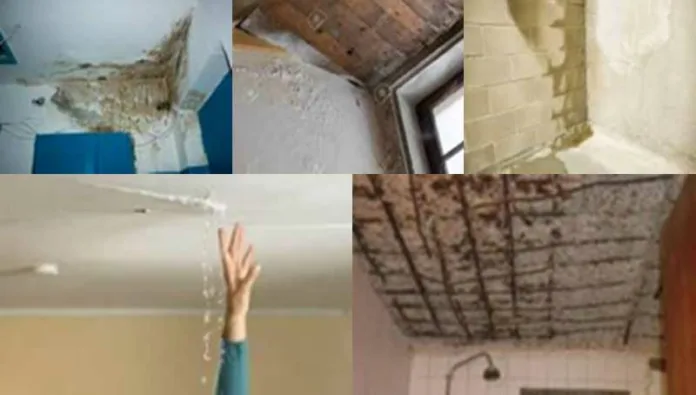
Leakages gradually develop over time, leaving a lasting impact. They begin as small patches or scars, with signs of wetness, sweating, dripping, flowing, and eventually oozing. These progressive stages present us with opportunities to take corrective measures and protect structures from further damage. Once water penetrates a surface, it initiates a process of deterioration, corroding the reinforcement steel and ultimately leading to the premature failure of the entire structure. Waterproofing can help address the leakage issue. Waterproofing refers to the process of identifying and addressing water leakage issues in a building or structure. It involves implementing measures to prevent water from infiltrating through walls, roofs, foundations, or other vulnerable areas, thereby protecting the structure and its contents from water damage. The circumstances and challenges faced in waterproofing projects are often diverse and not easily repetitive.
Dilemma of leakage
In apartment complexes or buildings, it is commonly thought that if there is a leak on the top floor, only the affected units should bear the responsibility and suffer the consequences. However, it is important to realize that if the steel on the top floor begins to corrode, it can spread like gangrene and affect the entire building. Lower floor occupants should be more mindful and cautious, as the collapse of the floor above would cause more damage to the floor below. Additionally, it is important to remember that their floor serves as the roof for those above them.
Waterproofing preventative process and maintenance;
There are two main types of waterproofing: preventive processes and maintenance used to prevent water ingress.
Waterproofing maintenance refers to the regular inspection, cleaning, and repair activities undertaken to maintain the integrity and performance of waterproofing systems. It involves proactive measures to prevent water leakage, moisture intrusion, and potential damage to structures.Maintenance can be further divided into two categories: preventive maintenance, which should be conducted once every seven years (considered the life cycle of waterproofing), and reactive maintenance, which is performed in response to existing damages.
The preventive process of waterproofing involves a series of steps and measures taken to prevent water intrusion and protect structures from moisture damage. In the preventive process, various methods and materials are employed, such as integral waterproofing, laminates, and coatings.
Different methods and materials used for waterproofing preventative measures;
Integral waterproofing
Integral waterproofing involves adding admixtures to the concrete during construction to enhance its waterproofing properties. This approach is akin to vaccination, where proactive measures are taken based on the assumption that certain issues may arise in the future. However, it is important to note that even with preventive measures, 100% effectiveness cannot be guaranteed, as leakages may occur due to various factors.

Laminates
Laminates involve the application of materials such as felts, membranes (e.g., APP or bitumen), FRP, FRG, ceramic, jute, cotton cloth, and various adhesives such as bitumen or solvent-based/solventless resins like PU or silicone. It can also include tiles made of different materials like marble, granite, stone, vitrified, or cement-based tiles.
Brick bat coba, PCC, and Screeds
Brick bat coba, PCC, and screeds are also used in waterproofing, although brick bat coba primarily serves as an insulation layer rather than providing waterproofing. Screeds are susceptible to the same vulnerabilities as the main slab.

Waterproofing coatings
Coatings are available in various types such as cementitious, silicone, PU, polyurea, ceramic, and composite materials. Cementitious coatings are compatible with concrete but may require additives like composites in nano forms to enhance their effectiveness. These coatings can be applied to both new and old buildings, including surfaces like tiles, lime mortar, and PCC, without the need for drilling, cutting, or removing the existing surface. They are suitable for water running bodies such as roofs, canals, and cascades, as well as water-holding bodies like sumps and reservoirs.
Composite ceramic nano coatings from AKWOSHIELD
Composite ceramic nano coatings, such as PERFECTCOAT-TR, are user-friendly, effective, economical, and eco-friendly. They offer thermal resistance in both high and low temperatures, ranging from -40°C to 1000°C in different versions. These coatings can be applied to various surfaces, including cured mud, lime mortar, bricks, stones, glass, wood, metal, and cement surfaces like blocks, tiles, concrete, and PCC. They provide anti-corrosive properties over metal surfaces and waterproofing over cement surfaces. Additionally, they offer heat and crack resistance, as well as resistance to algae, fungi, and viruses.

As an impregnate, the coating seeps through with water as the carrier and begins to set upon encountering an obstacle where water is retained for a short period. The hardening process reverses, pushing out any collected water over time, thereby reducing the risk and damage of corrosion. It is normal for leakages to temporarily increase after applying this coating, drying out gradually over a period of about 8 weeks, depending on the volume of water collected on the surface or in sunken areas. The application process is simple and can be done by do-it-yourself (DIY) enthusiasts. It can be used in both new and old projects, including surfaces with lime mortar that are over 100 years old.
The unique selling points (USPs) of impregnates like AKWOSHIELD are that they are composed of ceramic, possess nano properties, and utilize water as a carrier. They can be applied even on surfaces that are wet or in water lagoon areas, including various types of tiles made of mud, cement, vitrified, stone, marble, kota, granite, and more.
In most cases, the use of reinforcements like screeds or breaking is not required, unless there are loose tiles or air pockets. These coatings are effective, economical, and eco-friendly. They can be applied to any surface involving cement, either as a lining or as a whole, and they enhance the strength of the surface by filling voids and making it watertight.
AKWOSHIELD® can be used to augment strength of concrete, fill voids, cracks, also with paint, coat it by itself, as admixture etc. This can be used to stop leaks in both water running bodies like roof tops, balconies, bath rooms, canals and water holding bodies like sumps, reservoirs, dams etc.
Conclusion
Implementing preventive measures in waterproofing is essential for maintaining the integrity and performance of structures and preventing water-related damage. By following a systematic approach, property owners can proactively address potential issues before they escalate, extending the lifespan of the waterproofing system and safeguarding the building. It is crucial to consult with waterproofing professionals and adhere to manufacturers’ guidelines for specific maintenance recommendations based on the type of waterproofing system in use.Remember, prevention is key in waterproofing.
About Author;
The author began his career in 1990 and has extensive experience in promoting engineering products for over 100 applications across various industries such as construction, defense, rail, aircraft, infrastructure, and engineering equipment. He has also ventured into manufacturing waterproofing compounds, which are engineered products. He has independently invented a series of consumable products for the construction and engineering industries, handling products for thousands of applications.
The author is well-known as an application and product development technologist who specializes in promoting technically advanced products developed by themselves and others. Some of the products they have developed include thermal insulation, fire-resistant materials, chemical-resistant materials, and waterproofing compounds such as coatings, mortars, bricks, tiles, punning, and lining materials. Most

